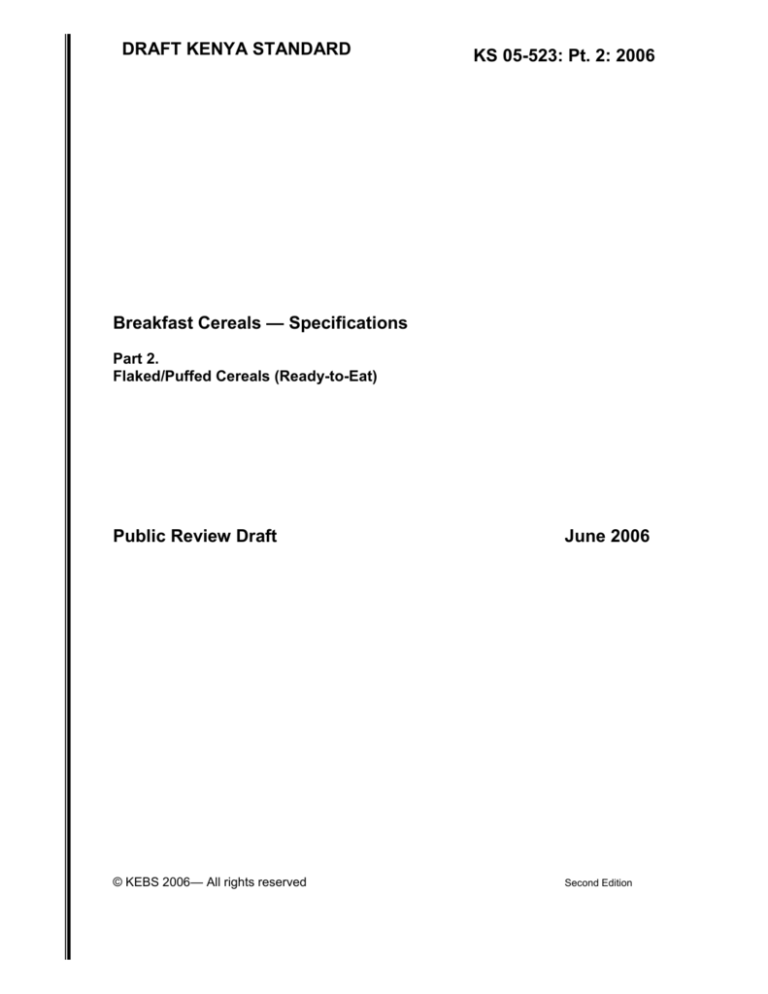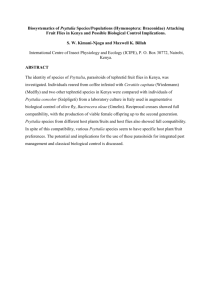
DRAFT
KENYA
STANDARD
DRAFT
KENYA
STANDARD
KS 05-523: Pt. 2: 2006
Breakfast Cereals — Specifications
Part 2.
Flaked/Puffed Cereals (Ready-to-Eat)
Public Review Draft
June 2006
© KEBS 2006— All rights reserved
Second Edition
DRAFT KENYA STANDARD
KS 05-523: Pt. 2: 2006
TECHNICAL COMMITTEE REPRESENTATION
Division of Nutrition — Ministry of Health
Consumer Information Network
National Cereals and Produce Board
Department of Public Health — Ministry of Health
JKUAT — Dept. of Food Science and Technology
HOM (Weetabix) Ltd.
Nestle Foods
Government Chemist’s Department
Institute of Packaging (Kenya)
Department of Industry — Ministry of Trade and Industry
Unga Limited
Proctor and Allan Ltd
Kenya Bureau of Standards — Secretariat
REVISION OF KENYA STANDARDS
In order to keep abreast with the progress in the industry, Kenya standards shall be regularly
reviewed. Suggestions for improvement of published standards are welcome and should be
addressed to the Managing Director, Kenya Bureau of Standards.
© Kenya Bureau of Standards, 2006
Copyright. Users are reminded that by virtue of section of the Copyright Act, Cap. 130 of the Laws of Kenya, copyright
subsists in all Kenya Standards and except as provided under section 7 of this Act, no Kenya Standard produced by
Kenya Bureau of Standards may be reproduced, stored in a retrieval system in any form or transmitted by any without
prior permission in writing from the Managing Director.
KS 05-523: Pt. 2: 2006
DRAFT KENYA STANDARD
KENYA STANDARD
Breakfast Cereals — Specifications
Part 2.
Flaked/Puffed Cereals (Ready-to-Eat)
KENYA BUREAU OF STANDARDS (KEBS)
Coast Region
P.O BOX 99376 Mombasa
Tel: (+254 041) 229563
E-mail: kebs-msa@swiftmombasa.com
Fax: (+254 041) 229448
Lake Region
P.O BOX 2949 Kisumu
Tel: (+254 057) 23549
E-mail: kebs-ksm@swiftkisumu.com
Fax: (+254 057) 21814
North Rift
P.O Box 2138 Nakuru
Tel: (+254 051) 210553
Fax: (+254 0321) 33150
DRAFT KENYA STANDARD
KS 05-523: Pt. 2: 2006
Foreward
This first revision of Kenya Standard was prepared by the Processed Cereals and Pulses
Technical Committee with the guidance of the Food Industry Standards Committee and is in
accordance with the procedures of the Bureau.
Breakfast cereal foods can be classified based on either the amount of time required for domestic
cooking, the form of the breakfast cereal or the cereal used as a raw material.
The types that require no cooking are called ready-to-eat cereals and these are available in a
variety of forms. The form covered in this standard is the flaked type. These ready-to-eat cereals
are consumed with milk and with or without added sugar.
This Kenya Standard stipulates the quality requirements for flaked breakfast cereals (ready-toeat) destined for human consumption. The standard stipulates the minimum enrichment
requirements for some vitamins and minerals, e.g. iron, thiamine, riboflavin, etc. which are partly
destroyed during production.
During the preparation of this standard, reference was made to the following documents:
Kent NL. (1983). Technology of Cereals. 3rd Edition. Pergamon press.
Breakfast cereals technology – By Roger Daniels – (Food technology review No. 11)
Encyclopaedia Britannica: Knowledge in Depth Vol. 3 (page 1171).
KS 05-40 Labelling of Pre-Packaged Foods (Parts 1 and 2)
FDA – Federal Rules Register, Vol. 39, No. 11 – USA.
Acknowledgement is hereby made for the assistance derived from these sources.
KS 05-523: Pt. 2: 2006
DRAFT KENYA STANDARD
Breakfast cereals: Part 2. Flaked/Puffed Cereals (ready-to-eat) —
Specifications
1
Scope
This Kenya Standard prescribes the requirements for flaked/puffed breakfast cereals,
which are ready-to-eat.
2.
General requirements
2.1
The cereal flakes/puffs shall be prepared from clean, sound grains, e.g. corn, wheat or
rice, which complies with relevant Kenya Standards or Regulations.
2.2
If the cereal flakes/puffs are prepared from cereal flour, the flour used shall be of good
quality and complying with various Kenya Standards on cereal flours.
2.3
The flakes/puffs shall be tender, crispy, and reasonably uniform in size and of good
flavour and colour. The cereal flakes/puffs shall possess a good characteristic taste and
odour and shall be free from rancid, musty, sour and other undesirable tastes and
odours. The flakes/puffs shall be free from insects, sand and any other extraneous
matter.
2.4
When immersed in milk or water the product shall readily absorb the liquid and swell
substantially presenting a pleasant texture and taste. The product shall not be soggy.
2.5
The wheat flaked biscuits shall be of good flavour, colour and of uniform size and design
within the group. The product shall not be soggy.
2.6
The sub clauses 2.3,2.4 and 2.5 shall be determined by sensory evaluation panels
2.7
Nutritional claims
There shall be no nutritional label claims regarding added nutrients unless such additions
complies with KS CAC/GL 23 Guidelines for use of Nutrition Claims.
3
Compositional requirements
The cereal flakes/puffs and flaked cereal biscuits (ready-to-eat) shall conform to the
requirements given in the tables below for each specific products.
Table 1 — Requirements for cornflakes/puffs per 100 g.
Characteristic
Requirement
Method of tests
Moisture (max) g
Protein (min.)* N X 6.25 g
Fat (max.) g
Ash (max.) g
Crude fibre (max.) g
4.0
8.0
3.0
6.0
2.5
KS 05-Pt. 1
,,
,,
,,
,,
* For sugar frosted cornflakes/puffs the protein shall be a minimum of 5/100g
© KEBS 2006— All rights reserved
1
KS 05-523: Pt. 2: 2006
DRAFT KENYA STANDARD
Table 2 —Requirements for wheat flakes/puffs and flaked wheat biscuits
per 100 g
Characteristic
Requirement
Method of tests
Moisture* (max) g
Protein (min.) N x 5.7g
Fat (max.) g
Crude fibre (max.) g
Ash (max.) g
6
9
2.3
3.5
6.0
KS 05-Pt. 1
,,
,,
,,
,,
* The moisture content of biscuits shall be a maximum of 7g/100g
Table 3 — Requirements for wheat bran flakes/puffs per 100g
Characteristic
Moisture (max.) g
Protein (N X 5.7) min. g
Fat g (max.)
Ash (max.) g
Dietary fibre (min.) g
Requirements
3.5
9.0
1.0
6.0
28
Method of tests
KS 05-Pt. 1
,,
,,
,,
,,
Table 4 — Requirements for rice flakes/puffs per 100 g
Characteristic
Requirement
Method of tests
Moisture (max.) g
Protein (N X 6.25) min. g
Fat g (max.)
Crude fibre (max.) g
Ash (max.) g
4.0
6.5
0.7
2.0
6.0
KS 05-Pt. 1
,,
,,
,,
,,
3
Hygiene
3.1
The product shall be prepared and packaged in the premises built and maintained under
hygienic condition in accordance with Public Health Act Cap 242, Food Drugs and
Chemicals Substances Act Cap 254 of the Laws of Kenya and Kenya Standard, KS 051500, Code of practice for hygiene in the food and drink manufacturing industry.
3.2
Microbiological requirement
The product shall conform to the microbiological limits in Table 2 below
Table 5— Microbiological Limits
Characteristic
Requirement
Test Method
Total plate count cfu/g
103
KS 05 220*
Coliform bacteria count/g
10
,,
Salmonella sp count/g
Shall be absent
,,
Escherishia Coli count/g
Shall be absent
,,
Staphylococcus aureus/30g
Shall be absent
,,
Mould/yeast per gram
< 300
,,
* Method of microbiological examination of food
3.3
The product shall not exceed total aflatoxins of 20ppb and 5ppb for aflatoxins B1
© KEBS 2006— All rights reserved
2
KS 05-523: Pt. 2: 2006
DRAFT KENYA STANDARD
4
Heavy Metal Contaminants
The flaked/puffed cereals shall comply with the heavy metal contaminants in the table below
Table 6— Heavy Metal Contaminants Limits
Contaminants
Limits in ppm Methods of Test
Arsenic (As), max,
Lead (Pb), max
Copper (Cu) max.
1.0
0.5
2.0
KS 05-140*
,,
,,
*Methods of test for processed fruit juices and vegetables
5
Packaging
5.1
The flaked/puffed cereals (Ready-to-Eat) shall be packed in well-sealed moisture proof
food grade containers, which will protect the product from deterioration in quality and safety
throughout the shelf life.
5.3
The fill of the container shall be packaged in accordance to the Weights and Measures
Act Cap. 513 of the Laws of Kenya.
6
Labelling
The labelling of the flaked/puffed cereals shall conform to Kenya Standard KS 05 40, labelling of
pre-packaged foods. In addition the following information shall be legibly and indelibly marked on
the container.
i) Name of the product;
ii) Brand name/ trade name;
iii) Name, location and physical address of the manufacturer;
iv) Country of origin;
v) Ingredients in descending order of proportions;
vi) Declaration of the nutritional information;
vii) Date of manufacture;
viii) Expiry date;
ix) Storage condition and
x) Net weight.
© KEBS 2006— All rights reserved
3






